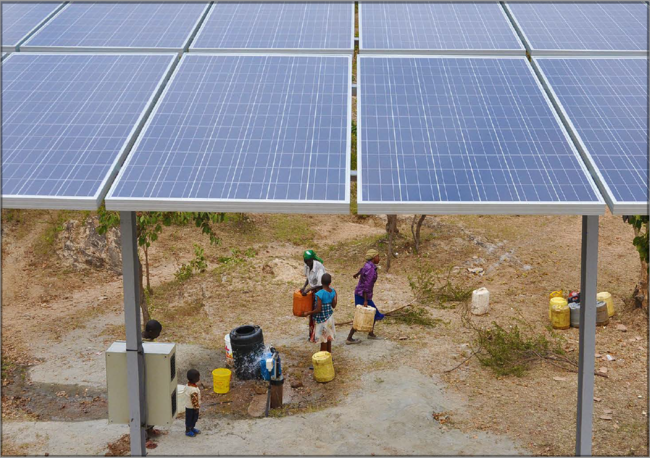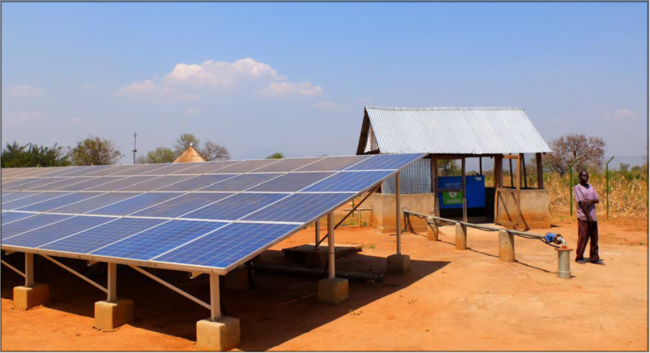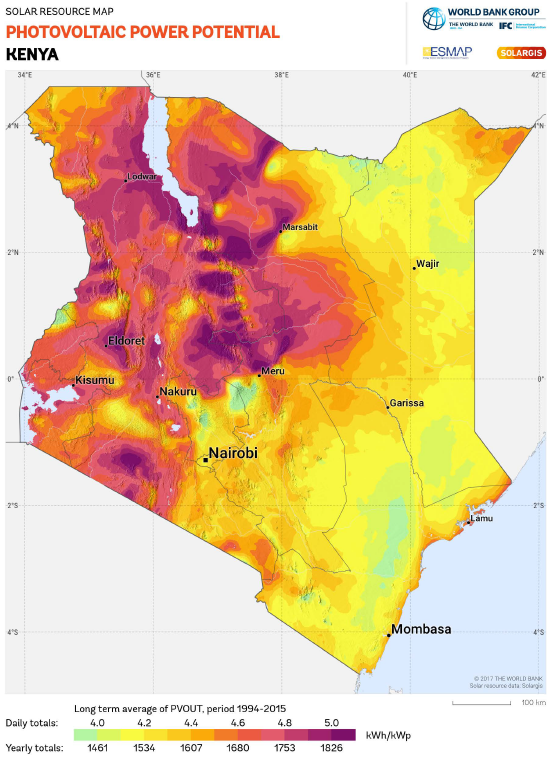Knowledge fuels change
For over a decade, Energypedia has shared free, reliable energy expertise with the world.
We’re now facing a serious funding gap.
Help keep this platform alive — your donation, big or small, truly matters!
Thank you for your support
Solar Pumping Toolkit - Guidance and Assessment
Solar Pumping Toolkit - The Global Solar & Water Initiative
Guidance Note, 2018: Improving Water Security through the use of Solar Energy
Rationale
Solar pumping technology has in the recent past undergone a series of technical and cost developments resulting in advanced, robust, versatile, low maintenance equipment that could be considered as a default option for water provision in places with medium to high solar radiation, especially in off-grid locations, long term camp contexts or there where fuel is needed to provide water but its supply is too costly or erratic. Favorable policies from an increasing number of governments together with presence of some trained private sector distributors of good quality solar equipment in literally every country, further support solar uptake and they should be counted upon in order to facilitate adoption of solar solutions for water supply projects -either for human, animal consumption or irrigation purposes-. From an energy intervention point of view, prioritization of smart-energy, life-saving activities that also lead to a reduction in expenditure over time should make the support of solar technology for water provision a priority intervention. Additionally, friendly environmental considerations make solar technology a climate-smart choice, especially when considered against any diesel-based option. The high potential for cost-reduction would be only realized if analysis and funding decisions are based in costs over life cycle of schemes rather than on capital costs of installations only.
Context 1 - Camps: mainstreaming of solar pumping
In camp contexts with a perspective of being in place for 2-3 years, solar pumping should be considered by default and from as early stage in time as possible, whenever they are able to meet a significant amount of the water demand. Stand-alone solar systems should be favored over Hybrid (solar + back-up power source) unless:
- Population figures are not well known or are prone to sudden increases at short notice
- Behavior of the aquifer is largely unknown
- Experience in solar pumping is low or inexistent among WASH partners or in the area of work
In older camps, solarization of water schemes should be prioritized looking first at a) camps with high recurrent costs to ensure water provision and b) water schemes where a stand-alone solar system can meet the water demand, since cost savings will be usually higher and Return on Investment shorter.
Context 2 - Host-communities: social aspects before technology choice
Solar pumping is, from the technical point of view, equally appropriate for water supply projects at host community level and it should be considered as a default option there where diesel generators are used, in order to increase sustainability of the system and resilience of communities.
As a difference with camps, aspects to do with ownership, operation and maintenance, add an extra-layer of complexity when considering solar pumping at host-community level.
A well thought social approach, involving contribution from users, should come before technology choice. In this sense, prioritizing communities with strong social cohesion and coordinating approaches with government water offices and/or private contractors with know-how on long term maintenance and repairs should be a pre-requisite.
When solar pumping should be discouraged
Solar pumping should not be seen as a blanket solution to every water supply project, and its use is discouraged in some cases, namely:
- When average solar radiation in the intended area of work falls under 4.0 PSH or 1,600kWh/m2 (i.e. Kenya's map below)
- When the expertise of the implementing agency is low and private sector support cannot be counted upon
- Where theft and/or vandalisms of solar schemes is widespread reported from past interventions
- Where solar technology does not bring any significant technical or economic advantage vs existing solutions
Since the design and operation of a solar scheme is almost entirely based in regular WASH work and data (i.e. right siting of water point, correct calculation of safe yield, etc), organizations doing good quality work in water supply will be much more likely able to implement good solar pumping schemes and should be prioritized, especially in regions or contexts where solar pumping is still to be introduced.
Current challenges
- Technical knowledge of most of WASH organizations remains low (leading to systematic use of solar pumping without understanding implications, and vice versa, rejecting the use of solar pumping without proper analysis).
- Measures has to be put in place in most of the cases to prevent theft of solar modules
- Availability of technicians and spare parts normally only at capital level
- (for host populations) Transitioning to a much more spaced use of water fees, since it might take years for breakdowns to happen, can take time and adjustments from partners and beneficiary host communities.
Operation & Maintenance, Training & Evaluation
Solar powered water schemes will suffer fewer breakdowns and have much less intensive maintenance than generator or hand pump schemes. However solar powered schemes can and will experience problems at some point that cannot be solved at community level (or for which the managing NGO will probably need support), regardless of the training provided.
As such it is important that if possible, service agreements are established prior to any installation, and renewed as years pass by, with a quality private contractor, water utility, water service provider of relevant government technical office. The possibility to remotely operate and monitor solar pumping schemes could also be considered in certain contexts as a way to reinforce preventive maintenance.
Since the single most important barrier towards a wider adoption of solar pumping solutions is the weak technical expertise of most WASH organizations, support should be encouraged to any solar training activity, that would as much as possible seek to benefit of the wider WASH sector in the country. Additionally, ways of collaboration (with for example academic institutions, knowledgeable private companies or water utilities) should be encouraged in order to make training activities as sustainable or prolonged in time as possible.
Finally, support to evaluations of older (+5 years) solar systems is to be encouraged in order to build up stronger evidence on the adequacy of solar pumping technology for the given context.
Facts & Figures
- Working life of solar modules warrantied to 25 years.
- Cost of solar modules reduced by 80% in the last 10 years.
- Cost recovery of solar pumping investments is on average 1 to 3 years.
- Cost reduction over life of the systems is -40% to -90% when compared to diesel generators
- Well designed and maintained solar systems can function over 10 years without any major failure
- Solar pumping Heads of +500m; pumping rates of +240 m 3 /h
- Service agreement average cost with contractors to ensure functionality, about 1,500 USD/ year
Strathmore SWP Course
Further Information: Mini-guide, Country Briefing and Video
- Miniguide: Solar Water Pumping
- Country Briefing_Case study of Bidibidi Refugee Settlement, Uganda
- GSWI Project Video: Summary of Findings
Technical Helpline
Anyone in the humanitarian sector interested in using solar for water supply can write to this address requesting for support. Or write directly to the contacts below.
References
- Contacts: Alberto Ibanez Llario & Asenath Ndegwa – The Global Solar & Water Initiative
Contacts
- Alberto Ibanez Llario & Asenath Ndegwa – The Global Solar & Water Initiative























